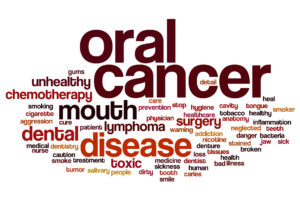
An oral cancer exam at the dentist can help detect precancerous or cancerous lesions at an early stage. The earlier oral cancer is identified, the earlier it can be properly treated.
Cancer kills over two million people annually. Of these two million people, approximately 7,900 people will die from oral cancer. The death rate is so high because oral cancer is rarely detected in early stages. The best way to reduce this risk is to have an oral cancer exam at the dentist.
Why Have an Oral Cancer Exam at the Dentist?
Dentists are often the first healthcare providers to recognize the early symptoms of oral cancer. This deadly disease occurs mostly on the tongue and lips. However, it can also be found on gum tissue, cheek lining, and palate. It generally will metastasize to the cervical lymph nodes in the neck. The most common form of oral cancer is squamous cell carcinomas.
Oral Cancer Causes and Risk Factors
Mouth cancer occurs when cells in the mouth or on the lips develop DNA mutations. Accumulation of these abnormal cells can cause a tumor. Over time, these cells may spread to other areas of the head, neck, or body.
Incidences of mouth and throat cancers have been on the rise in recent years. Among other things, the HPV virus has been shown to be responsible for a rise in incidence of oral cancer.
Individuals who have a family history of the disease are more likely to benefit from an oral cancer exam at the dentist. However, it’s a good idea for all individuals to have a least two oral cancer exams per year to keep their health in check.
Certain factors can increase the risk of mouth and throat cancer, including:
- Tobacco products: Cigars, cigarettes, snuff, chewing tobacco, pipe tobacco, and similar products are the number one risk factor for oral cancer.
- Alcohol use: Heavy alcohol use can contribute to the development of oral cancer. Alcohol is especially dangerous when combined with tobacco use.
- Significant sun exposure: Extended periods of time in direct sunlight can increase the risk for lip cancer.
- History of oral cancer: Individuals who have had oral cancer in the past are more likely to develop the disease again in the future. Furthermore, those with a family history of mouth or throat cancer are at a higher risk.
- Gender: Statistically, men are more likely to develop oral cancer than women.
- Age: Men and women over the age of 40 are at a higher risk for developing mouth or throat cancer
If you suspect you could be at a higher risk for this disease, an oral cancer screening could detect problems before they develop.
Symptoms and Warning Signs of Oral Cancer
There are certain warning signs that could indicate oral cancer. Some possible symptoms include:
- Red or white patches on the inside of the mouth
- Suspicious lumps or bumps on the gums, floor of the mouth, base of the tongue, or other soft tissues
- Difficulty chewing or swallowing
- Pain or discomfort
- Loose teeth
- Pain that radiates up to your ear
- A mouth sore that doesn’t heal
Keep in mind that there may not be any visible symptoms. That’s why an oral cancer exam at the dentist is necessary for optimal health.
How to Prevent Oral Cancer
While there’s no sure fire way to prevent oral cancer altogether, there are a few things you can do to reduce your risk.
- Avoid tobacco products. Whether chewed or smoked, tobacco exposes the mouth cells to dangerous chemicals.
- Use moderation when it comes to alcoholic beverages. Excessive alcohol can irritate the oral soft tissues. This makes them more vulnerable to cancer. Avoid alcohol altogether or limit your intake to one drink per day.
- Use plenty of sun protection. In addition to regular sunscreen, apply a sunscreen lip balm. Wear a large wide-brimmed hat when outside to protect your face from direct sunlight and harmful UV rays.
- Visit your dentist regularly. An oral cancer exam during a dental checkup is one of the best ways to protect yourself from this disease. If lesions are discovered early, there is a much better chance that they can be removed effectively.
What to Expect during an Oral Cancer Exam at the Dentist
The American Dental Association recommends that all patients undergo an oral cancer exam at the dentist. This is typically completed during a regular dental visit.
Your dentist will visually assess the soft tissues inside your oral cavity. He or she will check your lips, cheeks, gums, base of the tongue, and floor of the mouth for any abnormalities.
After a visual exam, your dentist may palpate certain areas of your neck and throat. This helps identify any suspicious lumps or bumps.
What if Something Suspicious is Found?
If something suspicious is detected during an oral cancer exam at the dentist, you will be referred to an oncologist for further testing. If the results are positive, you will work with your medical team to find a treatment that is right for you. This may include:
- Targeted drug therapy
- Chemotherapy
- Radiation therapy
- Surgery
- Immunotherapy
Schedule an Oral Cancer Exam at the Dentist
A checkup exam can help identify signs of oral cancer. Ask for an oral cancer exam at the dentist and take a significant step in protecting your health.
